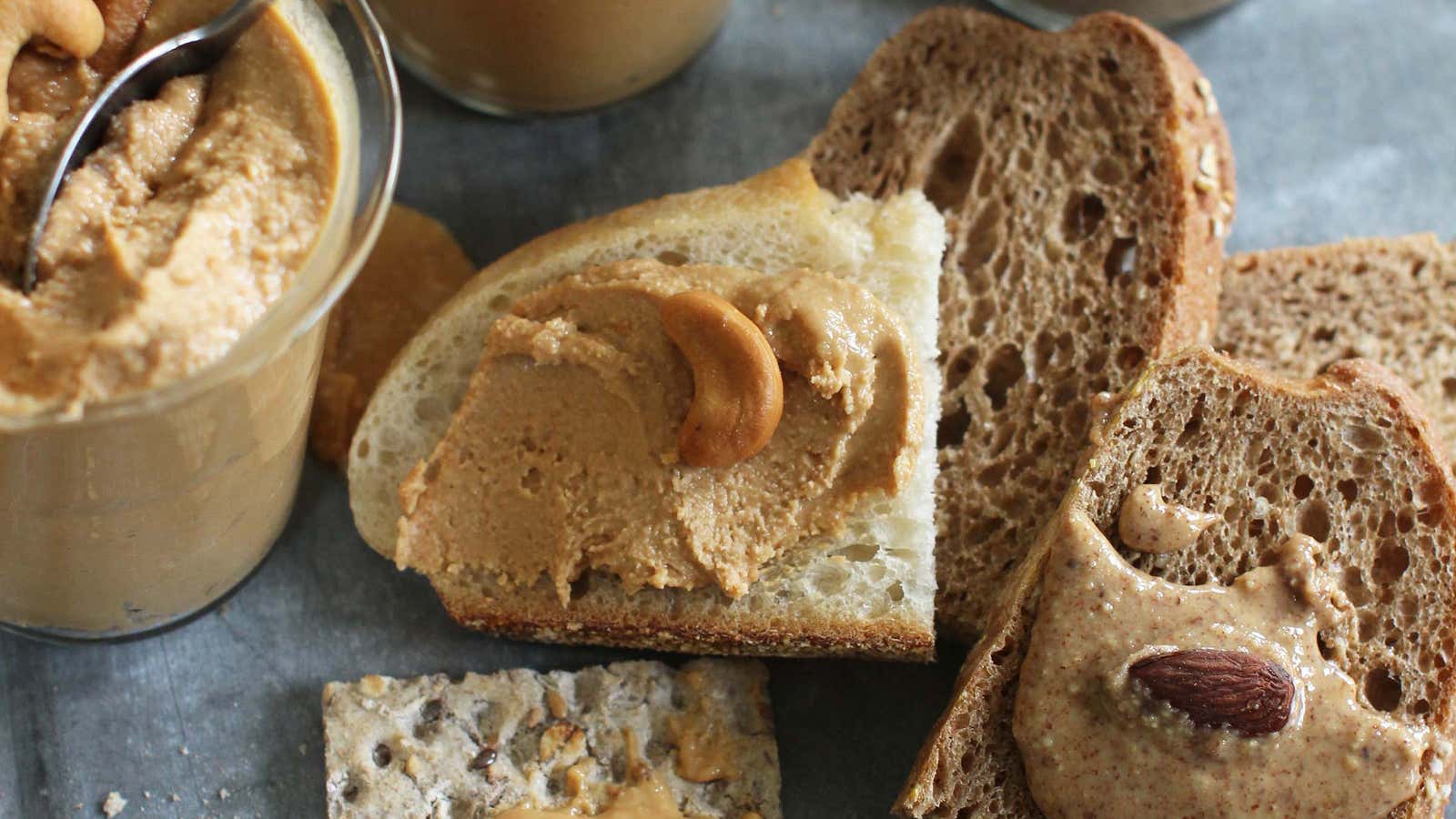Nut butters are having a moment. While peanut butter remains the most affordable option, plenty of consumers shell out double or triple its price for almond butter, cashew butter, or other unconventional varieties of ground nuts.
The recent rise in peanut-related allergies may have a lot to do with it. Since 2010, the prevalence of childhood peanut allergies has leaped 21%, according to 2017 data from the American College of Allergy, Asthma, and Immunology. While tree-nut allergies are also a growing concern (peanuts are a legume), the fact that many schools now ban peanut products is one likely explanation for the profusion of nut butters.
Beyond allergies, consumers may view expensive tree-nut butters as healthier alternatives to peanut butter. And not without reason: some popular eating trends, namely Paleo diets, warn against the consumption of peanuts. Recent research has also linked almonds to heart health benefits, and attributed healthy microbiome changes to walnuts.
They may be cheaper, but are peanuts and peanut butter any less healthy?
“Nothing I know would support that,” says Richard Mattes, a distinguished professor of nutrition at Purdue University.
Back in 2008, Mattes co-authored a comprehensive review on the role of peanuts and tree nuts in weight loss and obesity. While both peanuts and tree nuts are high-fat, calorie-dense foods, Mattes’ review found that eating them does not increase a person’s risk of weight gain or obesity. Some evidence suggests that eating nuts, including peanuts, may aid weight loss.
“First, nuts and peanuts are very satiating, and so people tend to eat less at other times of the day,” he says. “Second, the energy from nuts and peanuts is not efficiently extracted”—meaning a good chunk (about 20%) of the calories these foods contain are never absorbed into your body, he explains. “And third, eating nuts and peanuts might lead to a rise in resting energy expenditure.” Mattes says this last benefit is “a little less well-documented.” A paper he published in 2002 found that normal-weight adults who added a six-tablespoon portion of peanuts to their daily diet enjoyed an 11% jump in their resting energy expenditure, or the amount of energy they burned just sitting around.
Mattes’ study was on peanuts—not peanut butter. And he says consuming nuts in butter form increases your gut’s absorption of their calories. “With nut butters, the cell walls [of the nuts] have been broken down mechanically in ways that liberate that energy,” Mattes explains. But while consuming nut butters may increase the number of calories you take in—and, depending on the products you buy, your overall intake of sugar, added oil, sodium, and other additives—it also increases your gut’s absorption of a nut’s healthy nutrients.
“The way I pitch it is if you’re trying to manage your weight, whole nuts are the way to go,” Mattes says. “If you’re trying to get the most nutrients, nut butters may have a slight edge.”
Of course, peanuts aren’t nuts at all. They’re legumes, which makes them cousins of foods like beans, lentils, and chickpeas. This makes them off limits for those adhering to Paleo diets, which consider legumes to be sources of dangerous “anti-nutrients” that promote GI problems and disease. There’s little real-world evidence linking the consumption of legumes to these health concerns.
Mattes says peanuts and tree nuts are actually quite similar when it comes to their nutrient profiles. In terms of their healthy monounsaturated and polyunsaturated fatty acid profiles, peanuts and almonds are actually more alike to each other than either is to a walnut. A half cup of peanuts contains 18 grams of protein and 6 grams of fiber, according to USD nutrition estimates. The same amount of cashews packs 13 grams of protein and 2 grams of fiber, while almonds contain 15 grams and 9 grams, respectively. Pick a vitamin or mineral, and one slightly outpaces the others. Cashews are champs when it comes to iron, while almonds contain high amounts of calcium, and peanuts pack the most folate.
Still, peanut butter is not without its potential downsides. “There have been problems with mold on peanuts, in some cases involving aflatoxins,” says Dr. David Ludwig, a professor of nutrition at Harvard School of Public Health. Aflatoxins are produced by fungi that grow on peanuts and other foods, and they’ve been linked with increased risks for illness and some cancers. But, to this point, aflatoxin outbreaks have turned up mostly in developing countries—not in the US.
“It’s fine to have peanuts [and] peanut butter a couple times a week as a tasty source of generally healthy fats, protein, and fiber,” Ludwig says. He also recommends mixing in other types of nut butters to capitalize on their diverse range of healthy fats and plant chemicals.
This is no doubt prudent advice. The takeaway isn’t that peanut butter is superior to other nut butters—or that you should be spooning it onto everything you eat. “Too much is too much,” Mattes says. Rather, if you’ve eschewed peanut butter in favor of other types of nuts or nut butters because you figured those were healthier, the existing evidence suggests good old peanut butter is just as good for you as the pricey alternatives.
This story was originally published on Medium.
